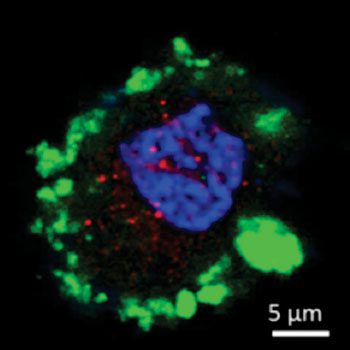Genetically Engineered Lactobacilli Cure Diabetes in Rat Model
By LabMedica International staff writers
Posted on 10 Feb 2015
A novel concept for treating diabetes was demonstrated by feeding diabetic rats a diet containing human lactobacilli that had been genetically engineered to secrete the protein glucagon-like peptide-1 GLP-1(1–37), which induced significant long-term increases in insulin levels.Posted on 10 Feb 2015
The inactive full-length form of GLP-1(1–37) has been shown previously to stimulate conversion of both rat and human intestinal epithelial cells into insulin-secreting cells. GLP-1 is normally induced by feeding and stimulates insulin secretion in response to glucose. It is a member of the incretin group of gastrointestinal hormones that cause an increase in the amount of insulin released from the beta cells of the islets of Langerhans after eating, even before blood glucose levels become elevated. They also slow the rate of absorption of nutrients into the blood stream by reducing gastric emptying and may directly reduce food intake. Incretins also inhibit glucagon release from the alpha cells of the Islets of Langerhans.

Image: Micrograph showing a rat cell re-programmed to express HNF-6 (red) and insulin (green). The nucleus is stained blue (Photo courtesy of Cornell University).
Investigators at Cornell University (Ithaca, NY, USA) examined whether oral administration of human commensal bacteria engineered to secrete GLP-1(1–37) could modulate glucose metabolism in a rat model of diabetes by reprogramming intestinal cells into glucose-responsive insulin-secreting cells. Toward this end they genetically engineered a strain of Lactobacillus to secrete GPL-1(1-37). The bacteria were fed to diabetic rats for 90 days.
Results published in the January 27, 2015, online edition of the journal Diabetes revealed that the rats receiving the engineered bacteria demonstrated a reduction of up to 30% in blood glucose levels. These rats developed insulin-producing cells within the upper intestine in numbers sufficient to replace approximately 25%–33% of the insulin capacity of nondiabetic healthy rats. Intestinal tissues in rats with reprogrammed cells expressed the pancreatic beta-cell markers MafA (mast cell function-associated antigen), PDX-1 (insulin promoter factor 1), and FoxA2 (forkhead box protein A2). HNF-6 (hepatocyte nuclear factor-6) expression was observed only in crypt epithelia expressing insulin and not in epithelia located higher on the villous axis.
Staining for other cell markers in rats treated with GLP-1(1–37)-secreting bacteria suggested that normal cells were not affected by the close physical proximity of reprogrammed cells.
“The amount of time to reduce glucose levels following a meal is the same as in a normal rat, and it is matched to the amount of glucose in the blood, just as it would be with a normal-functioning pancreas,” said senior author Dr. John D. March, professor of biological and environmental engineering at Cornell University. “It is moving the center of glucose control from the pancreas to the upper intestine.”
The GLP-1 technology has been licensed by BioPancreate, a wholly-owned subsidiary of the biopharmaceutical company Cortendo AB (Radnor, PA, USA), which will be attempting to adapt it for use as therapy for human diabetes.
Related Links:
Cornell University
Cortendo AB




 assay.jpg)









